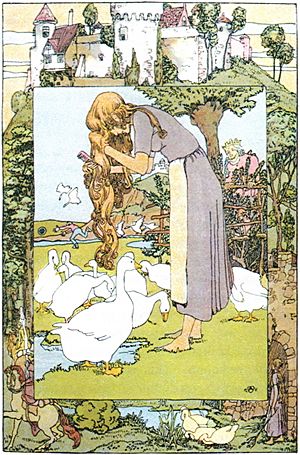The Goose Girl facts for kids
Quick facts for kids "The Goose Girl" |
|
|---|---|

"The Goose Girl" Illustration by Heinrich Vogeler
|
|
| Author | Brothers Grimm |
| Original title | "Die Gänsemagd" |
| Country | Germany |
| Language | German |
| Genre(s) | Fairy tale |
| Published in | Kinder- und Hausmärchen (Children's and Household Tales — Grimms' Fairy Tales) |
| Publication type | Fairy tale collection |
| Publication date | 1815 |
The Goose Girl is a classic German fairy tale. It was collected by the famous Brothers Grimm. They first published it in their book Grimms' Fairy Tales in 1815. This story is known as KHM 89 in their collection.
The tale was first put into English in 1826. Many other people have translated it since then. For example, Andrew Lang included it in The Blue Fairy Book in 1889.
Contents
Where the Story Comes From
The Brothers Grimm first shared "The Goose Girl" in 1815. It was part of the second volume of their book, Kinder- und Hausmärchen. In that first edition, it was story number 3. Later, in the 1819 edition, it became story number 89.
The Grimms heard this story from a German storyteller. Her name was Dorothea Viehmann. She was a very important source for many of their tales.
What Happens in the Story
The story begins with a queen who is a widow. She sends her daughter, a princess, to another country. The princess is going there to marry a prince. With her travels her magical horse, Falada, who can talk. A waiting maid also goes along. The queen gives her daughter a special charm. This charm will keep her safe as long as she wears it.
The Journey and the Maid's Betrayal
The princess and her maid travel for a while. Soon, the princess becomes very thirsty. She asks her maid to get her some water. But the maid refuses to help. She tells the princess to get the water herself. The princess has to drink from a stream. She feels sad and whispers, "What will become of me?" Her charm answers, "Alas, alas, if your mother knew, her loving heart would break in two."
Later, the princess gets thirsty again. She asks the maid for water one more time. Again, the maid refuses to help. She makes the princess drink from the river with her hands. As the princess bends down, her special charm falls out. It floats away in the water.
The Maid Takes Over
The maid sees that the princess is now helpless. She forces the princess to switch clothes with her. They also swap horses. The maid threatens to kill the princess. She makes the princess promise not to tell anyone about this. The sad princess has to agree.
The maid then rides Falada, pretending to be the princess. The real princess rides the maid's horse. When they arrive at the palace, the maid acts like the princess. The true princess is told to guard the geese. She works with a young boy named Conrad.
Falada's Head
The false princess is worried about Falada. She fears the talking horse might reveal her secret. So, she orders Falada to be killed. The real princess hears this sad news. She begs the slaughterer for one favor. She asks him to nail Falada's head above the doorway. This is the doorway she passes every morning with her geese.
Each morning, the goose girl speaks to Falada's head. She says, "Falada, Falada, you are dead, and all the joy in my life has fled." And Falada's head answers, "Alas, alas, if your mother knew, her loving heart would break in two."
Conrad and the King
One day, Conrad watches the princess comb her beautiful golden hair. He wants to take some of her hair. But the goose girl sees him. She says a magic charm. The wind blows Conrad's hat away. He cannot come back until her hair is combed.
Conrad gets angry and tells the king what happened. He says he will not herd geese with this girl anymore. The king tells him to go one more time. The next morning, the king hides and watches. He sees everything Conrad described.
That evening, the king asks the princess to tell her story. But she cannot break her oath. The king suggests she tell her story to the iron stove. She agrees and climbs inside. She tells everything to the stove. The king listens from outside.
Justice and a Happy Ending
The king now knows the truth. He has the goose girl dressed in royal clothes. Then, he tricks the false princess. He asks her what punishment a servant should get for lying. The false princess suggests a very harsh punishment. She says such a servant should be dragged through town in a barrel with spikes. The king then orders that she receive that very punishment for her deception.
After this, the prince and the true princess get married. They rule their kingdom happily for many years.
Similar Stories
"The Goose Girl" is a type of story called a "false bride" tale. In these stories, a good person is tricked. Someone else takes their place. This tale is like other stories where a maid takes over the princess's role.
Similar ideas are found in other old tales. For example, "The Golden Bracelet" from America has some of these same parts. There are also old poems and romances with similar themes. One example is "The Lord of Lorn and the False Steward."

